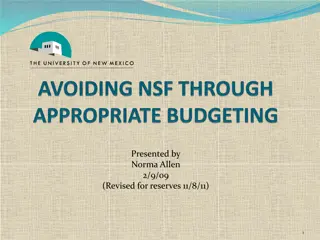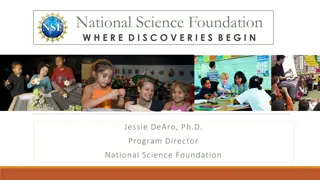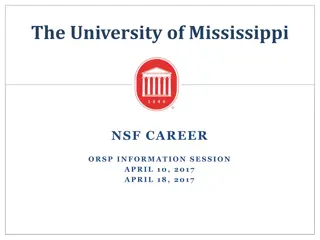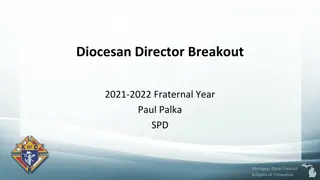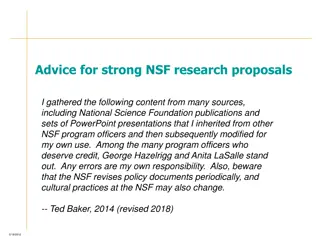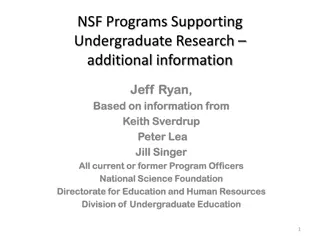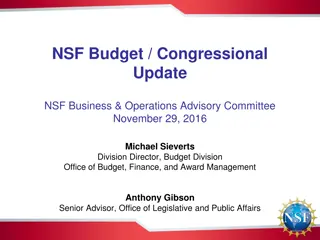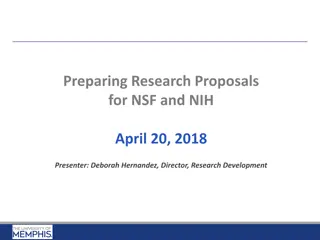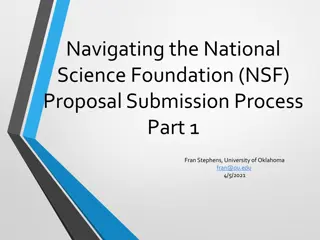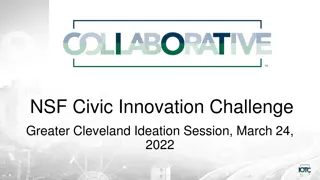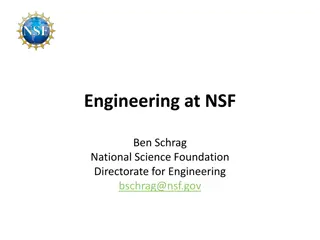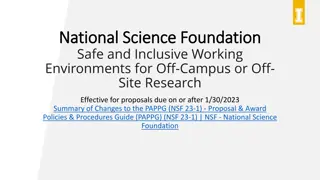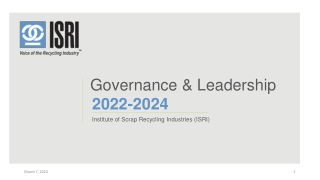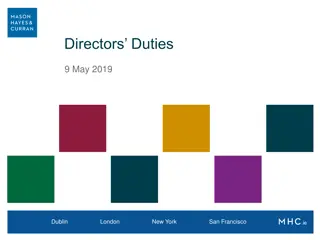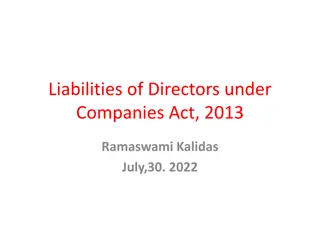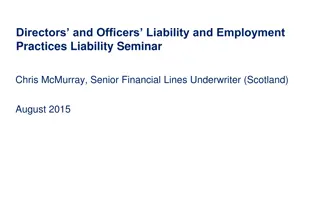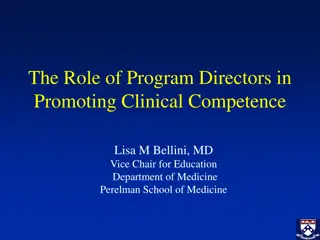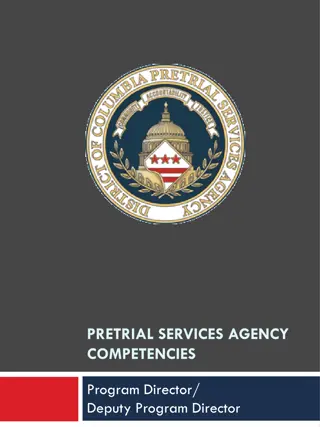Insights from a Season at NSF: Program Director's Perspective
An experienced Program Director at NSF shares personal insights and experiences working within the Algorithmic Foundations group, overseeing programs in areas like robotics and scalable systems. The role of a Program Director, the structure of NSF, and the funding mechanisms for basic research are discussed, offering valuable information for researchers interested in NSF opportunities.
Download Presentation

Please find below an Image/Link to download the presentation.
The content on the website is provided AS IS for your information and personal use only. It may not be sold, licensed, or shared on other websites without obtaining consent from the author. Download presentation by click this link. If you encounter any issues during the download, it is possible that the publisher has removed the file from their server.
E N D
Presentation Transcript
Insights from a season at NSF Peter Brass Program Director (Rotator) Algorithmic Foundations, NSF November 2022
Caveats I am a year and a half in the Program Director position at NSF All this is just my personal opinion and experience, not an NSF document I belong to the Algorithmic Foundations group within the CCF division in the CISE directorate. Other parts of NSF might have different perspectives. The programs I am currently involved in are Algorithmic Foundations Core AF Foundational Research in Robotics FRR Principles and Practices of Scalable Systems PPoSS Internet Measurement Research REU Sites
What is a Program Director? (1) Program Directors are the basis of the scientific side of NSF. They run panels, communicate with researchers, recommend awards. They answer questions. They supervise and manage awards from the NSF side. They document the decision processes. They manage funding in and between programs. They work on solicitations and new programs. They discuss the direction research funding is going.
What is a Program Director? (2) About half of the Program Directors are Rotators from universities the other half are permanent federal employees Rotators typically come from mid-range public universities. They serve on an IPA assignment and stay employees of their home institution. Salary stays the same, but they get summer salary. A rotation typically lasts one to three years. Each group is always looking for candidates for rotator positions. If you are interested, speak with a program director in the relevant program. They need to know that you are interested.
National Science Foundation Main mechanism of federal funding of basic research. Applied research funding comes from other federal departments Budget about $8.5B in Fiscal Year 2021 probably significantly more now Congress always thinks well of NSF Funding mechanism are Grants, not Contracts much less administrative work for researcher more suitable for explorative research with unknown outcome
NSF Structure Eight Directorates and a couple of Offices, among them Computer and Information Science and Engineering (CISE) Engineering (ENGR) Mathematical and Physical Science (MPS) Each Directorate subdivided into Divisions, each Division further subdivided and each group has its own way of doing things.
Funding Process (1) NSF creates a program, either by a solicitation or by a description. A solicitation is specific about what is wanted: topic, funding amount, eligibility etc. The things stated in the solicitation are required. Proposals that are not responsive to the solicitation get rejected. A description is less specific. It advises to discuss the ideas with a Program Director before writing the proposal. Such a proposal is an unsolicited proposal. They have greater freedom, but the path to funding is more difficult. They are bound only by the PAPPG (Proposals & Awards Policies & Procedures Guide).
Funding Process (2) PIs write proposals, and submit them, with the help and approval of their institution s grants officer. The institution submits the proposal. Within NSF, the proposal is tested for formal correctness, and assigned to a Program Director of the appropriate program. Here are problems if the proposal does not fit the program well. The PD decides how to gather information, by a panel or by ad-hoc reviewers. Each proposal gets at least three external reviews. A panel discusses the proposals, produces a discussion summary and usually ranks the proposals, and divides them into groups. Proposals might be discussed by several panels
Funding Process (3) The PD looks at the information provided by panels and ad-hoc reviewers, for each proposal in the program, and at the program budget, and makes a funding recommendation. The funding recommendations are presented to the division director, who usually concurs. Then the proposal goes to the Division of Grants and Agreements, which reviews the process, and the college information, and ultimately produces the award letter. Until the award letter, everything is just a recommendation, and might change.
Funding Process (4) This is the basic path of a proposal from submission to decision. Proposals may take more complicated paths if they are discussed on multiple panels or if the funding comes from multiple sources within or outside the NSF. Especially for large projects, complicated negotiations might be needed. 75% of all submissions should be decided within 6 months. The remaining 25% can sometimes take much longer. PIs contribute to delay by missing reports. Budget uncertainty makes PDs hold back proposals.
Funding Process (5) The money is awarded to the institution, not to the PI. The institution commits to undertake the research in the project. The PI is employee of the institution. The institution is responsible for the research (e.g., scientific misconduct) The institution is responsible for the PI (e.g., harassment) The institution is responsible for use of the money (e.g., fraud) There is no way the institution can return money to the NSF; any money not used up goes to the US Treasury. Money expires about six years after it was given to the institution and is automatically returned to the Treasury. That is a federal rule.
Post-Award Process (1) Each project requires annual reports. If a project report becomes overdue, all NSF processes related to the PI and all co-PIs of that project are blocked. If your project report is overdue, your co-PI cannot get a new award. You hurt others by overdue reports. Award funds need to be spent; don t try to stretch a three-year award to six years. Awards should be spent roughly according to the budget.
Post-Award Process (2) PIs who have an active award might get supplements to it, most important REU supplements, which fund an undergraduate student for a summer. REU supplement requests need a clear and realistic plan what the student should do. REU supplement requests should contain some description of the preliminary work on the project. REU supplements do not go out to external review and can be granted on fairly short notice. We give at most two REU supplements per year per project, each at $8000.
Post-Award Process (3) When a project reaches its end date, it is closed, and left-over money is returned to the US Treasury. The end date can be delayed by requesting a no-cost extension. The NCE must be obtained before the project is closed. The first NCE can be approved by the local sponsored programs office. Further NCEs require approval by the NSF. As long as the grant is active, REU supplements can be requested. No extension is possible beyond the moment the funds reach the six year federal limit.
Advice on Proposal Writing (1) Read the Solicitation Before Writing the Proposal It is an incorrect belief that whatever the research is, there is some program that will be interested in it. Although PDs try to help getting a proposal to the right program, rewriting might be necessary. There is research no program is interested in. Research has to be described in a way that makes it interesting to the target program. Each program has its own expectations.
Advice on Proposal Writing (2) Write so that the panel members can understand the proposal and find it interesting. Panel members can be from all over the research community. They are probably more distant to your specialty than you think. Programs that have no deadlines need to process submissions as they come, so they have less specialized panels. But also show the specialist on the panel that you know the details and have read all relevant literature.
Advice on Proposal Writing (3) Proposals need Coherence. A proposal that goes in multiple directions will be judged by the panel according to its weakest part. Even if the parts are good, a proposal might be rejected for lack of coherence. A collaborative proposal needs actual collaboration; if it really is just the union of independent projects, it will fail. Writing a good Medium or Large proposal is difficult, since it needs to justify that all the parts belong together and are synergistic. The larger the proposal, the stronger the management and supervision requirements. This is also on the NSF side: large projects are much work.
Advice on Proposal Writing (4) A proposal needs Depth. There must be a spectrum from easy to difficult targets, so that it is clear where the PI starts and then works his way up. For each target, there must be an explanation why it is interesting in the context of this proposal, a review of the current state of research, and some ideas what to try to reach that target. Too many targets are generally not a good sign; the panel tends to say laundry list . It must be clear what success on a target means.
Advice on Proposal Writing (5) Each proposal is judged on its Intellectual Merit and Broader Impact, as well as possible further solicitation-specific criteria. These criteria have to be explicitly addressed in the proposal. Without Intellectual Merit a proposal has no chance, but among many proposals with similar Intellectual Merit, Broader Impact can make a difference. A claim of Broader Impact needs evidence. Not this has many applications or many students were reached , but concrete evidence and numbers. Take it seriously to be convincing.
Advice on Proposal Writing (6) Broader Impact is impact beyond what would be expected from any project in the field. You don t get credit for doing what everyone does anyway. Broader Impact can be outreach, activities for the community like workshops, teaching activities, broadening participation activities etc. Always give details and numbers. Broader Impact activities need not be new and unprecedented, but if it is just joining existing activities at the institution, the panel will ask why the PI did not do this before.
Advice on Proposal Writing (7) The panel judges the proposal that is written, not the proposal that could have been written, or was intended. Be clear in each statement. Make sure that what is written is what you mean. Define every term and concept. The readers of the proposal are different from the readers of your papers. Proofread the proposal. Panelist can get irritated about typos and grammar errors. Panels don t give much credit to famous names if they write careless proposals. Expectations for established researchers are higher.
Advice on Proposal Writing (8) Report your previously funded work and describe clearly how the current project differs from past funded projects. Panels complain if they feel it is more of the same Take the Current and Pending Support section seriously. Be complete. This is where legal difficulties might happen. You cannot get the same project funded from several institutions; the government pays only once for the work. Work funded by foreign institutions, or undertaken in other countries, has special rules.
Advice on Proposal Writing (9) The Budget needs to be reasonable for the program: Expectations depend on the program, different in CS or Math For a Small (3years, $600k) or a CAREER, CISE expects about one month summer salary and one graduate student. Other things as you can fit them in, but don t bloat the budget. We cut. The time commitment must be reasonable for the work. Adding a co-PI with 0.1 month summer salary makes us wonder about the role in the project. Don t add a symbolic co-PI just for the name. After the award is made, you can locally rebudget within reason.
Advice on Proposal Writing (10) The Biographical section has a prescribed structure, and needs to follow rules. List all affiliations, current and past, paid and unpaid. They might generate conflicts. Undeclared affiliations can cause real legal problems. If you generate any form of data, including software, you need a data management plan. Under which license is software released? (e.g., GPL) How is generated data preserved and made available to other researchers? If you have a postdoc in the budget, you need a postdoc mentoring plan.
Advice on Proposal Writing (11) The Proposal needs a title that is Short Descriptive Specific Who looks at a proposal is determined by the title, or in a spreadsheet, by the beginning of the title. A bad title might miss the attention of the relevant PD or reviewer. Reconsider the title after finishing the proposal narrative.


